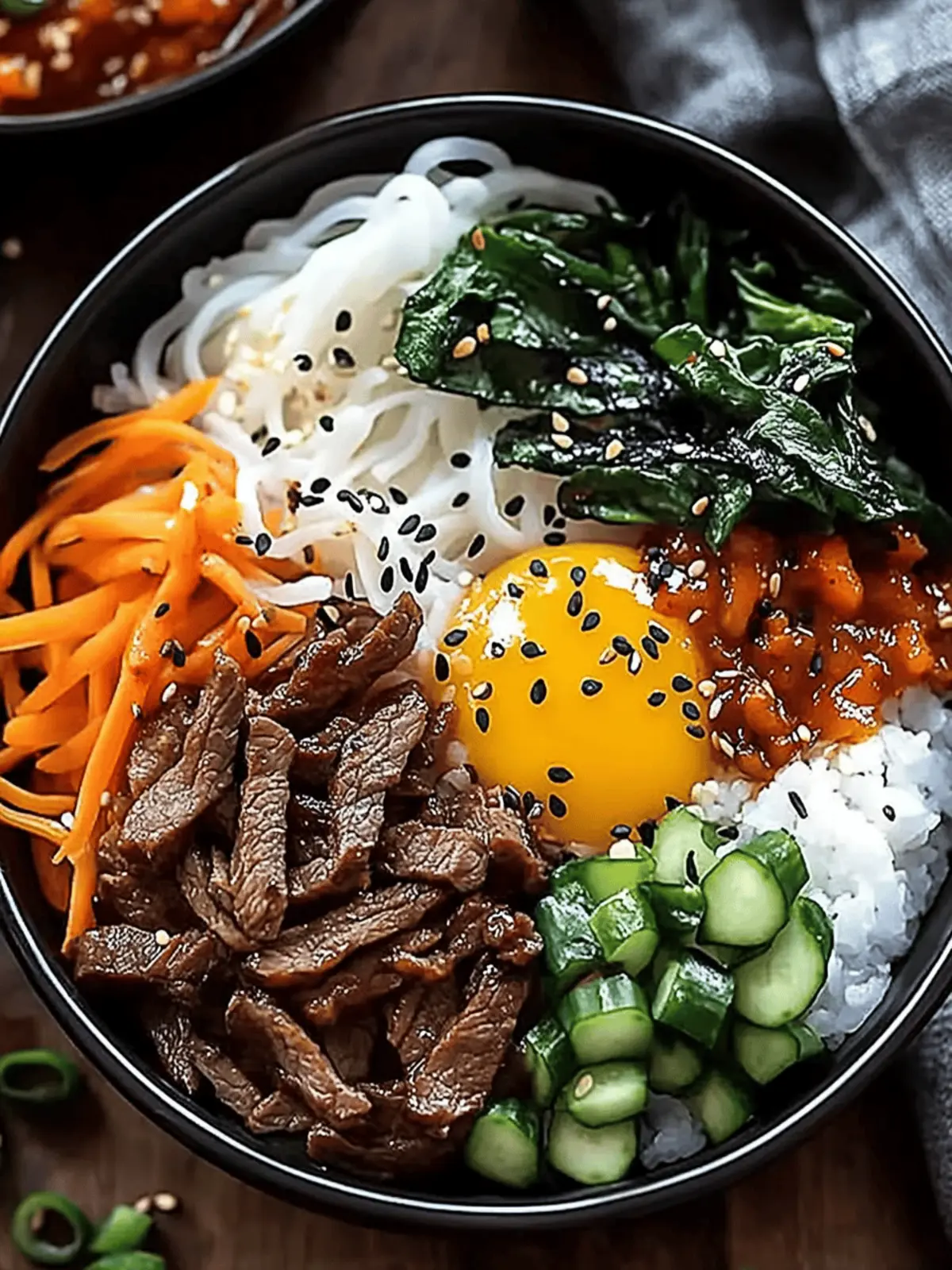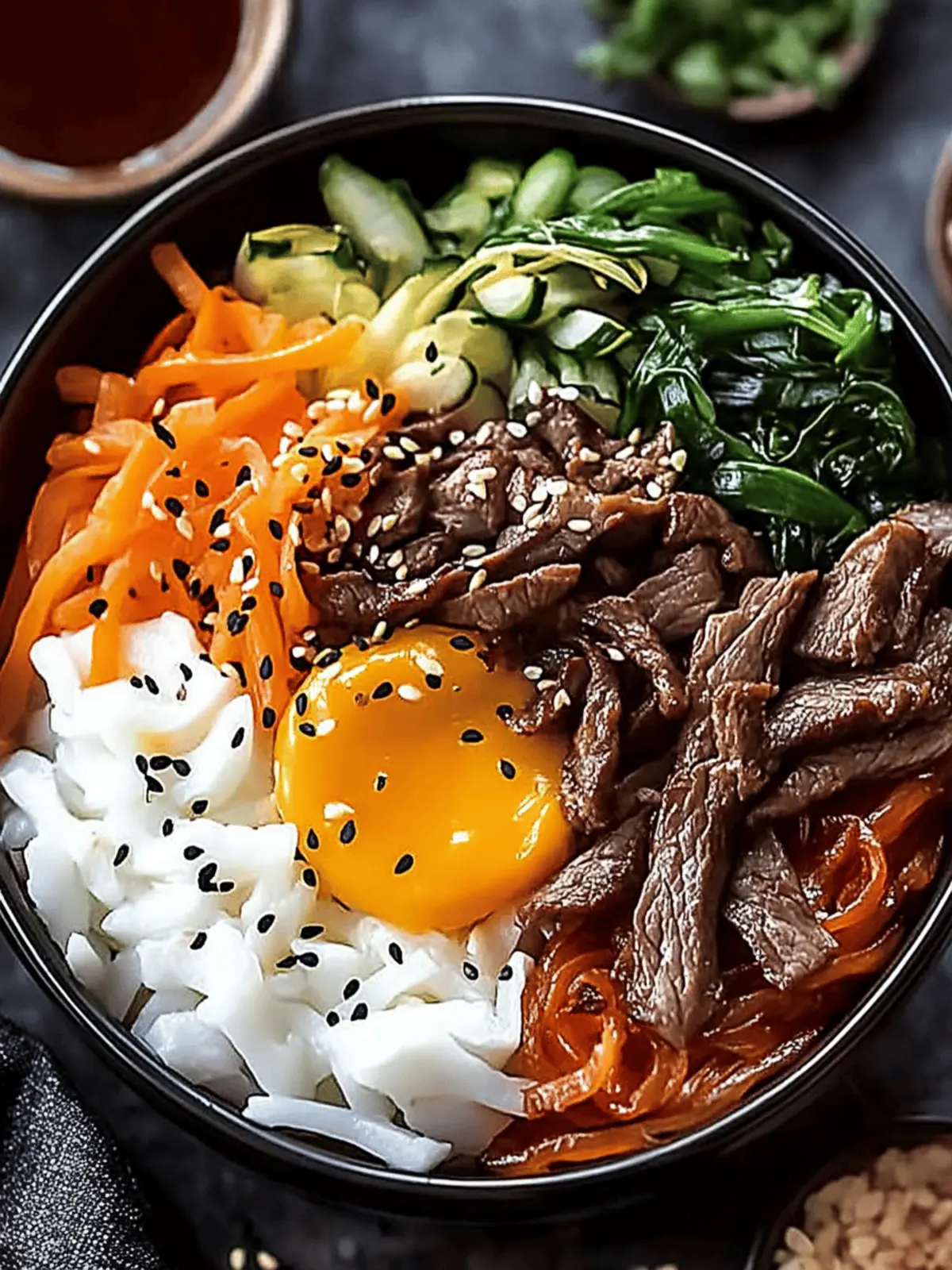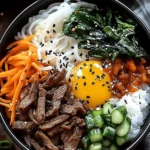There’s something exhilarating about bringing the vibrant tastes of Korea right into my kitchen, especially on busy weeknights when the fridge is running low. That’s how I stumbled upon the magical world of Korean Beef Bibimbap Bowls. This dish is a feast for the senses, combining marinated beef, crisp vegetables, and a perfectly sunny-side-up egg, all piled onto a warm bed of sticky rice.
I love how customizable this recipe is—whether you’re craving a meaty delight or a fresh vegetarian alternative, you can easily make this bowl your own. Each bite transports me to a bustling Seoul market, with the irresistible aroma of gochujang and sesame oil filling the air. Plus, it’s surprisingly quick to whip up! So, whether you want a delightful meal for the family or a crowd-pleasing dish for friends, this Korean Beef Bibimbap Bowl promises to deliver deliciousness and color that everyone will enjoy. Let’s dive into this incredible recipe!
Why Will You Love This Korean Beef Bibimbap Bowl?
Customization at Its Core: This recipe is truly customizable, allowing you to tailor your bowl to fit your taste preferences.
Quick and Easy: Perfect for busy weeknights, the entire dish can be prepared in under 30 minutes, freeing up your time for other evening activities.
Packed with Flavor: The savory marinated beef combined with vibrant vegetables creates an explosion of taste that keeps you coming back for more!
Nutritional Balance: Not only is it delicious, but this bowl is also well-balanced, brimming with protein, veggies, and wholesome carbs—making mealtime nourishing.
Great for Entertaining: Serve it family-style for gatherings and watch your friends marvel at the delightful spread—it’s a sure crowd-pleaser!
Experience the magic of this dish for yourself and impress your loved ones with effortless gourmet flair!
Korean Beef Bibimbap Bowl Ingredients
For the Beef
- Ground Beef – Choose lean cuts to keep it healthy and flavorful.
- Gochujang Sauce – Provides the essential heat and flavor; adjust according to your spice tolerance.
- Low-Sodium Soy Sauce – Adds umami depth; use tamari for a gluten-free version.
- Sesame Oil – Elevates aroma and taste; olive oil works in a pinch.
For the Rice
- Short-Grain White Rice – This is the dish’s base; ensures you achieve the beloved sticky texture.
For the Vegetables
- Carrots (Julienned) – Bring sweetness and a delightful crunch; bell peppers or radishes can work well too.
- Fresh Spinach – Adds vibrant color and nutrients; bok choy or kale are great alternatives.
- Zucchini (Sliced) – Offers mild flavor that absorbs other seasonings; eggplant is a suitable substitute.
- Bean Sprouts – Adds a lovely crunch and nutrition; can be left out for a lower-carb bowl.
For the Garnish
- Eggs – Add a sunny-side-up egg for that perfect runny yolk, tying all flavors together beautifully.
Dive into the joy of creating your own Korean Beef Bibimbap Bowl—the perfect canvas for creativity and flavor!
How to Make Korean Beef Bibimbap Bowl
-
Prepare the Rice: Rinse the short-grain white rice under cold water until the water runs clear, then cook according to package instructions (approximately 20 minutes). Once finished, fluff and set aside.
-
Cook the Beef: In a skillet over medium-high heat, brown the ground beef for 5-7 minutes until fully cooked. Drain any excess fat to keep it lean and flavorful.
-
Add Flavor: Stir in the gochujang, soy sauce, and sesame oil with the beef. Let it simmer on low for an additional 5 minutes to meld those delicious flavors together.
-
Sauté the Vegetables: In another pan, sauté carrots, spinach, zucchini, and bean sprouts in a splash of sesame oil for about 7 minutes until they are tender-crisp, vibrant, and full of color.
-
Fry the Eggs: Gently prepare sunny-side-up eggs in a non-stick pan, cooking for about 3 minutes until the whites are set but the yolks remain runny, adding richness to your bowl.
-
Assemble the Bowls: Start by layering the rice in bowls, followed by the beef mixture, the sautéed vegetables, and crown it all with the fried egg. Drizzle with additional gochujang if you like a bit more heat!
Optional: Garnish with sesame seeds or fresh herbs for an extra touch of flavor.
Exact quantities are listed in the recipe card below.
Expert Tips for Korean Beef Bibimbap Bowl
-
Rice Rinsing: Rinse your short-grain rice thoroughly to remove excess starch; this helps achieve the ideal sticky texture for bibimbap.
-
Marination Matters: Marinate your beef for at least 30 minutes to infuse maximum flavor; if time allows, marinating overnight yields the best results.
-
Avoid Overcrowding: When sautéing vegetables, avoid overcrowding the pan. This ensures they cook evenly and remain crisp, enhancing your bibimbap experience.
-
Customize Proteins: To make this dish vegetarian, replace ground beef with tofu or tempeh. Don’t forget to add nutritional yeast for extra umami!
-
Adjust Spice Levels: Start with less gochujang and adjust to your taste. You can always add more, but it’s hard to tone down heat once added!
Experience the joy of cooking your very own Korean Beef Bibimbap Bowl with these helpful tips!
What to Serve with Korean Beef Bibimbap Bowl?
Elevate your culinary experience by pairing this vibrant and customizable dish with delightful accompaniments that excite the senses.
-
Kimchi: This traditional fermented side dish brings a spicy kick and tangy flavor that balances the savory elements of bibimbap.
-
Crispy Egg Rolls: The crunchy exterior and savory filling add a wonderful texture contrast, making your meal more satisfying and delightful.
-
Sesame Cucumber Salad: Refreshing and light, this salad adds a cool crunch that brightens the flavors of the bowl, making everything feel integrated.
-
Miso Soup: A warm, umami-rich soup complements the hearty bowl, providing soothing warmth and a pleasing contrast with textures.
-
Steamed Dumplings: Juicy and flavorful, these bites provide a delightful element of fun and another dimension to your meal experience.
-
Spicy Tofu Bites: For a vegetarian twist, serve crispy tofu bites that offer protein and spice, enhancing the dish’s flavor profile beautifully.
-
Green Tea or Soju: Whether you prefer a calming cup of green tea or a shot of traditional soju, both drinks refresh the palate, creating a harmonious dining adventure.
With these pairings, your Korean Beef Bibimbap Bowl transforms into a feast that celebrates textures, flavors, and a delightful dining experience!
Make Ahead Options
These Korean Beef Bibimbap Bowls are perfect for busy meal prep enthusiasts! You can prepare the rice and beef mixture up to 3 days in advance. Simply cook the rice and allow it to cool before storing it in the refrigerator. For the beef, brown the ground beef and mix it with the gochujang and soy sauce, letting it cool before refrigerating. For maximum freshness, sauté the vegetables the day you plan to serve them. When ready to enjoy, just reheat the rice and beef in the microwave or on the stovetop, fry the eggs fresh, and assemble your vibrant bowls. You’ll savor all the flavors just as if they were made on the spot!
Storage Tips for Korean Beef Bibimbap Bowl
Room Temperature: Store any leftover cooked ingredients at room temperature for no more than 2 hours to maintain food safety.
Fridge: Keep any uneaten Korean Beef Bibimbap Bowl components in airtight containers in the fridge for up to 3 days; this helps preserve flavor and texture.
Freezer: For longer storage, freeze individual components—like the cooked beef or sautéed vegetables—for up to 3 months. Thaw in the fridge overnight before reheating.
Reheating: Gently reheat the beef mixture and vegetables in a skillet over low heat, adding a splash of water if needed to retain moisture. Enjoy the freshness of your homemade bibimbap!
Korean Beef Bibimbap Bowl Variations
Feel free to explore these delightful twists and turns to personalize your bibimbap experience!
-
Vegetarian: Substitute ground beef with tofu or tempeh for a plant-based delight. Add extra veggies for more flavor and texture.
-
Gluten-Free: Use tamari instead of soy sauce and ensure your gochujang is gluten-free. Enjoy the same great taste without worry!
-
Extra Crunch: Toss in crispy fried onions or crushed peanuts for a nutty texture contrast that will excite your palate.
-
Spicy Kick: Add sliced jalapeños or a sprinkle of chili flakes to elevate the heat. This adds a fiery dimension to every bite!
-
Sesame Twist: Try a sesame dressing instead of gochujang for a milder, nutty flavor profile. It’s perfect for those who prefer less spice.
-
Seasonal Veggies: Incorporate seasonal vegetables like asparagus or butternut squash. Their unique flavors keep your bibimbap fresh throughout the year.
-
Rice Alternatives: Swap out white rice for quinoa or cauliflower rice for a nutritious twist that suits a low-carb lifestyle.
-
Umami Boost: Add sliced shiitake mushrooms or fermented kimchi for a savory kick, adding depth of flavor that’s truly irresistible!
Korean Beef Bibimbap Bowl Recipe FAQs
How do I select the best ground beef for my Bibimbap Bowl?
When choosing ground beef for your Korean Beef Bibimbap Bowl, opt for lean cuts with about 80-90% lean meat. This gives you a savory flavor while keeping the dish from becoming overly greasy. Fresh meat should be bright red with minimal dark spots.
How should I store leftovers from the Bibimbap Bowl?
Store any uneaten components of your Korean Beef Bibimbap Bowl in airtight containers in the refrigerator. They will stay fresh for up to 3 days. To preserve the flavor and texture, keep the rice, beef, and vegetables stored separately until you’re ready to enjoy a second serving.
Can I freeze my Bibimbap components?
Absolutely! You can freeze the components of your Korean Beef Bibimbap Bowl individually for up to 3 months. To do this, let the cooked beef and sautéed vegetables cool completely before placing them in freezer-safe bags or containers. When you’re ready to enjoy, simply thaw them in the fridge overnight, then reheat in a skillet over low heat until warmed through.
What should I do if my vegetables are mushy after cooking?
If your sautéed vegetables ended up mushy, you may have overcrowded the pan during cooking. Next time, sauté in small batches to give them room to cook evenly and maintain that lovely crispness. Additionally, remember that cooking them too long can result in a loss of texture.
Is this recipe suitable for those with gluten intolerance?
Yes! Simply substitute the low-sodium soy sauce with tamari, a gluten-free alternative, and you can still enjoy the rich flavors of the Korean Beef Bibimbap Bowl. Just double-check that your gochujang sauce is gluten-free as well, as some brands may contain traces of gluten.
Can I make this bowl vegetarian?
Definitely! To create a vegetarian Korean Beef Bibimbap Bowl, replace the ground beef with tofu or tempeh. Make sure to press the tofu to drain excess moisture before cubing it and sautéing. You can also add nutritional yeast for that savory umami flavor, creating a delicious and hearty alternative!
Enjoy creating your own delightful version of this Korean Beef Bibimbap Bowl!

Savory Korean Beef Bibimbap Bowl That's Totally Customizable
Ingredients
Equipment
Method
- Rinse the short-grain white rice under cold water until it runs clear, then cook according to package instructions.
- In a skillet over medium-high heat, brown the ground beef for 5-7 minutes until cooked.
- Stir in the gochujang, soy sauce, and sesame oil with the beef. Simmer on low for 5 minutes.
- Sauté carrots, spinach, zucchini, and bean sprouts in a splash of sesame oil for about 7 minutes until tender-crisp.
- Prepare sunny-side-up eggs in a non-stick pan, cooking for about 3 minutes until the whites are set.
- Layer the rice in bowls, followed by the beef mixture, the sautéed vegetables, and top with the fried egg.







